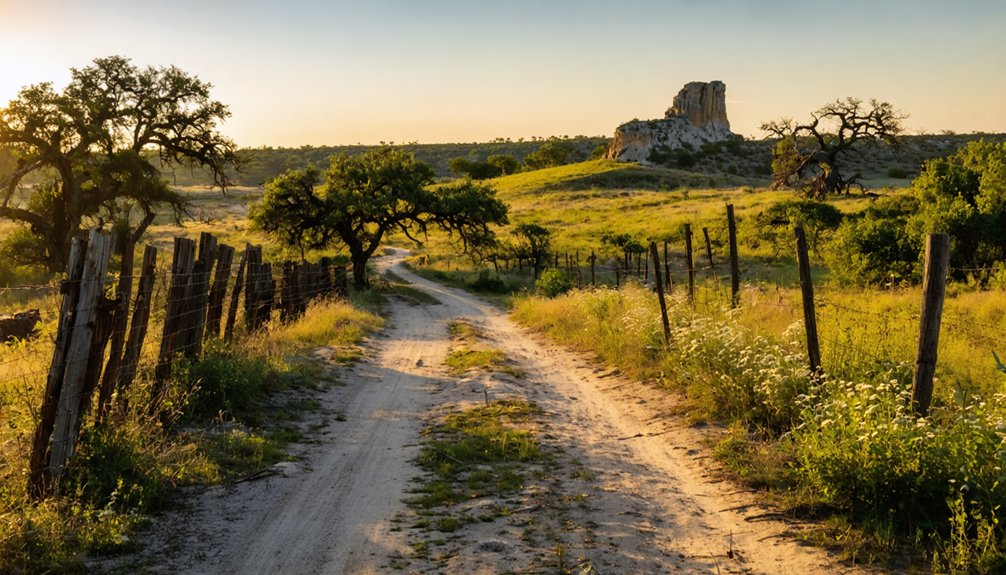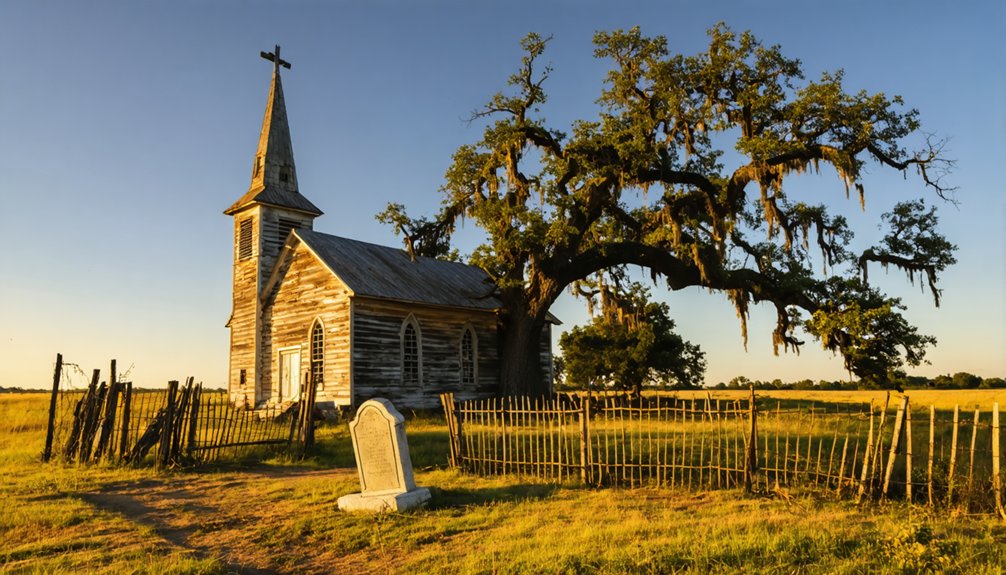You’ll find Penick ghost town in Jones County, Texas, where it emerged as a railway stop in the 1880s along the Wichita Valley Railway. The town served as an essential agricultural hub, supporting local ranching and cotton farming operations until economic challenges, including the devastating boll weevil invasion of 1915, led to its decline. Today, you can explore abandoned buildings and railway structures that tell the story of this once-thriving settlement’s rich past.
Key Takeaways
- Penick was established in 1905 as a railway stop on the Wichita Valley Railway line, serving as a vital agricultural transport hub.
- The town’s decline began with the rise of automobile transport and was further impacted by the 1915 boll weevil infestation.
- Abandoned buildings and deteriorating railway structures remain at the site, providing evidence of the former settlement’s existence.
- The ghost town is located in north-central Jones County, Texas, surrounded by rolling prairies and semi-arid Great Plains terrain.
- Visitors can best explore Penick during spring or fall, with historical research available through Jones County libraries and archives.
The Rise and Fall Along the Wichita Valley Railway
When the Wichita Valley Railway established its line through Jones County, Texas in the 1880s, it sparked the creation of Penick, a small settlement named after local rancher R. L. Penick.
The railroad’s significance became evident as the Wichita Valley Railroad Company incorporated in 1905, constructing a 60.7-mile line from Seymour to Stamford with Penick as a crucial station stop. The project began with a groundbreaking in November 1905. The railway became an integral part of the Colorado and Southern system, expanding its reach across multiple states.
You’ll find that Penick’s community dynamics revolved entirely around the railway, which enabled agricultural commerce and connected residents to broader markets.
But as automobile transport grew and railway operations changed, Penick’s strategic importance faded.
The town’s dependence on rail services ultimately led to its downfall when railroad companies merged and routes changed, transforming this once-bustling stop into a ghost town.
Life in 1880s Rural North-Central Texas
Life in 1880s rural north-central Texas demanded constant physical labor and resourcefulness from farming families near settlements like Penick.
You’d start your day hauling water from wells and chopping wood for your cast iron stove and fireplace. Household labor consumed everyone’s energy – from preserving food to tending vegetable gardens and livestock. Mothers would spend hours baking bread in coal ovens while managing other daily tasks.
Dawn to dusk meant endless chores – fetching water, splitting wood, tending gardens and animals to keep the household running.
You’d find relief through social interactions, gathering with neighbors for Sunday church services and evening singalongs. Your children would play homemade games like baseball and marbles, while you’d work the fields growing cotton for cash and corn for sustenance. Many families, like the Hancocks, relied on St. Stephens Church as a central gathering place for their community.
Despite the hardships of no electricity, limited medical care, and physically demanding farm work, you’d rely on your community’s support through shared meals, labor, and fellowship to sustain your family’s way of life.
Agricultural Legacy and Economic Impact
As Penick emerged near the Wichita Valley Railway in the 1880s, its economic foundation rested firmly on large-scale ranching operations led by influential figures like R.L. Penick.
You’ll find that the town’s strategic location along the railway proved essential for transporting cattle and later supporting crop diversification efforts.
The development of ranching was pioneered by Emmett Roberts and his brothers who established operations in 1873.
As the community shifted from ranching to small-scale farming, cotton became the dominant crop.
However, economic sustainability faced challenges, with farmers hauling cotton over 20 miles to markets in Albany and Abilene.
The railway’s presence initially bolstered the local economy, supporting important businesses like gins and general stores.
But when agricultural difficulties mounted, including declining cotton markets and transportation setbacks, Penick’s significance waned.
Similar to other Texas communities, the arrival of the boll weevil in 1915 devastated local cotton production.
Remnants of a Once-Thriving Settlement
You’ll find several abandoned buildings still standing at the Penick site, offering glimpses into its railway-dependent past along the Wichita Valley Railway.
The remnants include original homes and possible commercial structures that have weathered decades of abandonment in north-central Jones County. Like the town of Thurber, these structures serve as a testament to the era when black diamonds fueled Texas’s growth. Armed company guards once patrolled similar ghost towns to keep out union organizers and maintain control over workers.
These physical traces, along with surrounding agricultural lands that have largely returned to their natural state, tell the story of a small Texas settlement that couldn’t survive the declining importance of rail transportation.
Vanishing Railway Buildings Remain
The crumbling railway structures of Penick stand as silent sentinels to the town’s former significance. These remnants of the Wichita Valley Railway, dating back to the 1880s, reveal the once-vital role this settlement played in Texas’ rural commerce.
You’ll find deteriorating station buildings and track remnants that once bustled with agricultural shipments and passenger traffic. The Missouri Pacific Railroad gained control of these lines in 1928, marking a significant shift in the region’s rail operations.
The railway architecture reflects the practical designs of the late 19th century, though time hasn’t been kind to these historical structures. Unlike the vintage rail cars still operating on heritage lines today, these buildings have been left to decay.
Preservation challenges abound as wood rots, metal rusts, and foundations crumble from decades of neglect.
What you’re seeing are the last visible traces of Penick’s railroad boom era – freight depots and passenger facilities that served as the town’s economic backbone until the mid-20th century decline of rural rail transport.
Agricultural Land Tells Story
While modern farming operations now dominate the landscape, Penick’s agricultural roots stretch back to its 1880s founding as an essential railway hub.
You’ll find that the agricultural evolution of this area reflects the broader change of Texas farming, from small homesteads to today’s large-scale operations. The land itself reveals the story of changing farming techniques, as fields once worked by early settlers have merged into expansive agricultural enterprises.
- Traditional subsistence farming and ranching marked the initial settlement period
- Railway access enabled farmers to expand their operations and reach distant markets
- Large-scale modern agriculture has replaced the small family farms that once dotted the region
The area’s shift tells a compelling story of adaptation, as farming practices evolved from basic sustenance to industrial-scale production.
Natural Landscape and Geographic Features

Situated in north-central Jones County, Penick’s natural landscape reflects the characteristic features of Texas’s Great Plains region, with rolling prairies and semi-arid terrain dominating the area.
You’ll find natural vegetation adapted to the harsh climate conditions, including drought-resistant mesquite, juniper, and native grasses that blanket the gently undulating plains.
The area’s semi-arid climate brings hot summers and mild winters, with limited seasonal rainfall shaping the ecosystem.
While you won’t find major rivers or lakes directly in Penick, the landscape supports diverse wildlife, from white-tailed deer to coyotes and prairie birds.
The combination of wind patterns and modest precipitation has created an environment more suited to ranching than farming, with seasonal wildflowers adding splashes of color to the rugged terrain.
Planning Your Visit to a Lost Community
You’ll find the most favorable conditions for exploring Penick during spring and fall months when Texas temperatures are mild and rainfall is moderate.
Your visit requires careful preparation, including water, sturdy shoes, a first aid kit, and navigation tools since the site lacks modern amenities and clear markers.
To uncover Penick’s hidden history, bring a camera for documenting remaining structures, consult historical maps beforehand, and consider reaching out to the Jones County Historical Society for background information about specific locations of interest.
Best Time to Visit
When planning a visit to the ghost town of Penick, timing can greatly impact your experience. Spring exploration offers perfect conditions with mild temperatures and vibrant wildflowers, though you’ll want to watch for muddy terrain after rainfall.
Summer precautions become essential as temperatures frequently exceed 90°F, making early morning or late afternoon visits necessary for comfort and safety.
- Visit during spring or fall “golden hours” (shortly after sunrise or before sunset) for the best photography opportunities and comfortable temperatures
- Choose winter weekdays for maximum solitude, but pack warm layers and plan for shorter daylight hours
- Time your visit during clear weather to guarantee accessible roads and ideal conditions for exploring the railway traces and historic remnants
What to Pack
Preparing thoroughly for a visit to Penick’s abandoned settlement requires careful consideration of both basic necessities and specialized equipment. Your packing essentials should include plenty of water, sun protection, and sturdy footwear suited for rough terrain.
Pack lightweight, breathable clothing with layers for temperature changes, and don’t forget long sleeves and pants to guard against brush and insects.
Essential safety gear includes a first aid kit, insect repellent, and navigation tools like GPS or detailed maps.
You’ll want to bring documentation tools such as cameras and notebooks, plus a flashlight for shadowy areas. Remember to pack emergency supplies like a whistle, portable charger, and snack foods.
Bring gloves and a small hand shovel for careful site exploration, and always carry a trash bag to maintain the site’s preservation.
Finding Hidden History
Discovering Penick’s hidden history requires thoughtful research and planning before your visit to this remote Jones County ghost town. Since written records are scarce, you’ll need to piece together forgotten stories through county archives, historical newspapers, and local historical societies.
Hidden narratives often emerge from careful investigation of railroad records and agricultural documents from the 1880s onward.
- Start at Jones County libraries and archives to uncover maps, photographs, and personal accounts that reveal Penick’s railroad heritage.
- Document your findings with detailed notes, GPS coordinates, and photographs to preserve vanishing historical evidence.
- Connect with regional historians and ghost town enthusiasts who might share unpublished information about Penick’s past, including family histories and oral traditions.
Frequently Asked Questions
Are There Any Documented Paranormal Activities or Ghost Stories From Penick?
You won’t find any officially documented ghost sightings or haunted locations in Penick, though nearby Texas ghost towns report paranormal activity. Direct evidence of supernatural occurrences in Penick remains nonexistent.
What Happened to the Original Residents After They Left Penick?
You won’t find documented Penick migration patterns or descendant stories, as no official records track where residents went. They likely followed typical rural-to-urban moves toward larger Texas cities for better opportunities.
Did Penick Have Its Own School System During Its Active Years?
If you’d lived in Penick, your children likely attended nearby Waller schools instead. Historical records don’t show evidence of Penick having its own schoolhouse or independent education system during its active years.
Were There Any Notable Crimes or Incidents in Penick’s History?
You won’t find any notable crimes or incidents recorded in Penick’s history. Historical sources show no major criminal events, violent disputes, or infamous figures during the town’s existence as a railway settlement.
Did Any Famous or Historically Significant People Come From Penick?
You won’t find any documented Famous Residents or Historical Figures from Penick. Available records don’t indicate any notable individuals emerging from this small railway settlement during its brief existence.
References
- http://texappealmag.com/texas-ghost-towns-explore-haunting-remnants-of-forgotten-cities/
- https://www.amysatticss.com/ghost-towns/
- https://www.youtube.com/watch?v=phjUE19A8HM
- https://discovertexasoutdoors.com/places/penick/
- https://www.ghostsandgetaways.com/ghost-towns
- https://texashighways.com/culture/history/what-the-heck-is-a-ghost-town/
- https://en.wikipedia.org/wiki/List_of_ghost_towns_in_Texas
- https://www.tshaonline.org/handbook/online/articles/hvp35
- https://freepages.history.rootsweb.com/~gtusa/usa/tx.htm
- https://www.wichitavalleynrhs.org/copy-of-abilene-northern-railway



